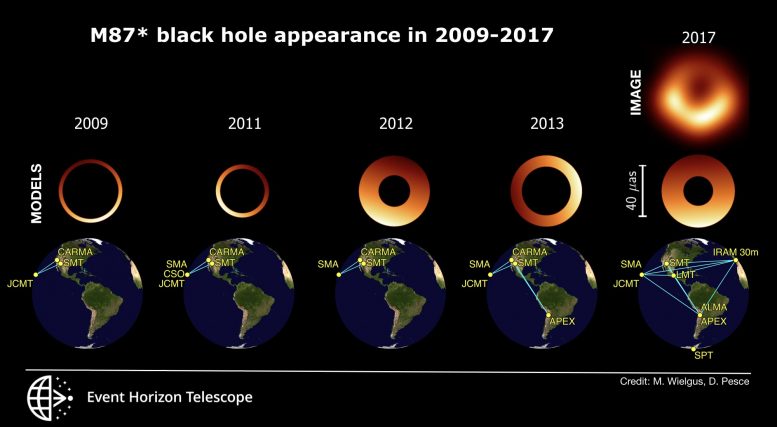
Snapshots of the M87* black hole appearance, obtained through imaging / geometric modeling, and the EHT array of telescopes in 2009-2017. The diameter of all rings is similar, but the location of the bright side varies. Credit: M. Wielgus, D. Pesce & the EHT Collaboration
Analysis of the event horizon telescope observations from 2009-2017 reveals turbulent evolution of the M87 black hole image.
In 2019, the Event Horizon Telescope (EHT) Collaboration delivered the first image of a black hole, revealing M87*–the supermassive object in the center of the M87 galaxy. The EHT team has now used the lessons learned last year to analyze the archival data sets from 2009-2013, some of them not published before. The analysis reveals the behavior of the black hole image across multiple years, indicating persistence of the crescent-like shadow feature, but also variation of its orientation–the crescent appears to be wobbling. The full results appeared today in The Astrophysical Journal.
The EHT is a global array of telescopes, performing synchronized observations using the technique of Very Long Baseline Interferometry (VLBI). Together they form a virtual Earth-sized radio dish, providing a uniquely high image resolution. “With the incredible angular resolution of the EHT we could observe a billiard game being played on the Moon and not lose track of the score!” said Maciek Wielgus, an astronomer at Center for Astrophysics | Harvard & Smithsonian, Black Hole Initiative Fellow, and lead author of the paper. In 2009-2013 M87* was observed by early-EHT prototype arrays, with telescopes located at three geographical sites in 2009-2012, and four sites in 2013. In 2017 the EHT reached maturity with telescopes located at five distinct geographical sites across the globe.
An animation representing one year of M87* image evolution according to numerical simulations. Measured position angle of the bright side of the crescent is shown, along with a 42 microarcsecond ring. For a part of the animation, image blurred to the EHT resolution is shown. Credit: G. Wong, B. Prather, C. Gammie, M. Wielgus & the EHT Collaboration
“Last year we saw an image of the shadow of a black hole, consisting of a bright crescent formed by hot plasma swirling around M87*, and a dark central part, where we expect the event horizon of the black hole to be,” said Wielgus. “But those results were based only on observations performed throughout a one-week window in April 2017, which is far too short to see a lot of changes. Based on last year’s results we asked the following questions: is this crescent-like morphology consistent with the archival data? Would the archival data indicate a similar size and orientation of the crescent?”
The 2009-2013 observations consist of far less data than the ones performed in 2017, making it impossible to create an image. Instead, the EHT team used statistical modeling to look at changes in the appearance of M87* over time. While no assumptions about the source morphology are made in the imaging approach, in the modeling approach the data are compared to a family of geometric templates, in this case rings of non-uniform brightness. A statistical framework is then employed to determine if the data are consistent with such models and to find the best-fitting model parameters.
Expanding the analysis to the 2009-2017 observations, scientists have shown that M87* adheres to theoretical expectations. The black hole’s shadow diameter has remained consistent with the prediction of Einstein’s theory of general relativity for a black hole of 6.5 billion solar masses. “In this study, we show that the general morphology, or presence of an asymmetric ring, most likely persists on timescales of several years,” said Kazu Akiyama, a Jansky Fellow of the National Radio Astronomy Observatory (NRAO) at MIT Haystack Observatory, and a contributor to the project. “The consistency throughout multiple observational epochs gives us more confidence than ever about the nature of M87* and the origin of the shadow.”
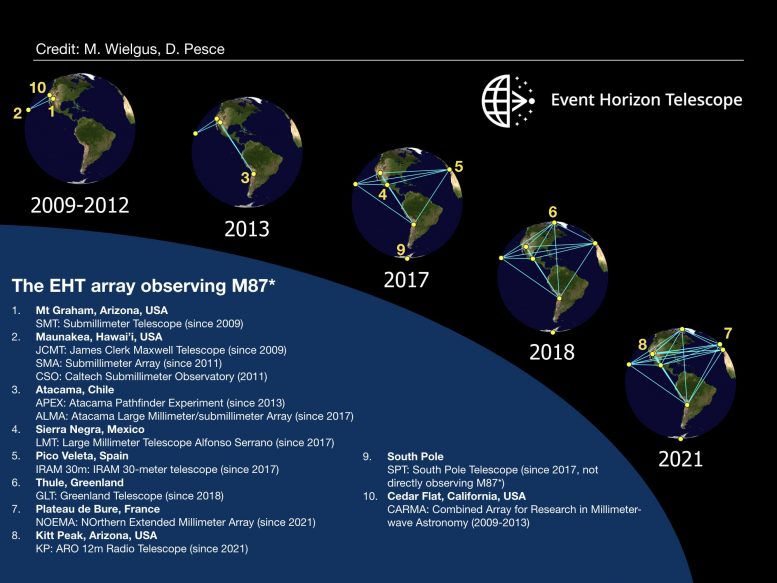
Telescopes participating in the EHT observations of M87* in 2009-2018 and the array expected in 2021. Credit: M. Wielgus, D. Pesce & the EHT Collaboration
But while the crescent diameter remained consistent, the EHT team found that the data were hiding a surprise: the ring wobbles, and that means big news for scientists. For the first time, they can get a glimpse of the dynamical structure of the accretion flow so close to the black hole’s event horizon, in extreme gravity conditions. Studying this region holds the key to understanding phenomena such as relativistic jet launching, and will allow scientists to formulate new tests of the theory of General Relativity.
The gas falling onto a black hole heats up to billions of degrees, ionizes, and becomes turbulent in the presence of magnetic fields. “Because the flow of matter is turbulent, the crescent appears to wobble with time,” said Wielgus. “Actually, we see quite a lot of variation there, and not all theoretical models of accretion allow for so much wobbling. What it means is that we can start ruling out some of the models based on the observed source dynamics.”
“These early-EHT experiments provide us with a treasure trove of long-term observations that the current EHT, even with its remarkable imaging capability, cannot match,” said Shep Doeleman, Founding Director, EHT. “When we first measured the size of M87* in 2009, we couldn’t have foreseen that it would give us the first glimpse of black hole dynamics. If you want to see a black hole evolve over a decade, there is no substitute for having a decade of data.”
EHT Project Scientist Geoffrey Bower, Research Scientist of the Academia Sinica, Institute of Astronomy and Astrophysics (ASIAA), added, “Monitoring M87* with an expanded EHT array will provide new images and much richer data sets to study the turbulent dynamics. We are already working on analyzing the data from 2018 observations, obtained with an additional telescope located in Greenland. In 2021 we are planning observations with two more sites, providing extraordinary imaging quality. This is a really exciting time to study black holes!”
Reference: “Monitoring the Morphology of M87* in 2009-2017 with the Event Horizon Telescope” by Maciek Wielgus, Kazunori Akiyama, Lindy Blackburn, Chi-kwan Chan, Jason Dexter, Sheperd S. Doeleman, Vincent L. Fish, Sara Issaoun, Michael D. Johnson, Thomas P. Krichbaum, Ru-Sen Lu, Dominic W. Pesce, George N. Wong, Geoffrey C. Bower, Avery E. Broderick, Andrew Chael, Koushik Chatterjee, Charles F. Gammie, Boris Georgiev, Kazuhiro Hada, Laurent Loinard, Sera Markoff, Daniel P. Marrone, Richard Plambeck, Jonathan Weintroub, Matthew Dexter, David H. E. MacMahon, Melvyn Wright, Antxon Alberdi, Walter Alef, Keiichi Asada, Rebecca Azulay, Anne-Kathrin Baczko, David Ball, Mislav Baloković, Enrico Barausse, John Barrett, Dan Bintley, Wilfred Boland, Katherine L. Bouman, Michael Bremer, Christiaan D. Brinkerink, Roger Brissenden, Silke Britzen, Dominique Broguiere, Thomas Bronzwaer … Doosoo Yoon, André Young, Ken Young, Ziri Younsi, Feng Yuan, Ye-Fei Yuan, J. Anton Zensus, Guangyao Zhao, Shan-Shan Zhao and Ziyan Zhu, 23 September 2020, The Astrophysical Journal.
DOI: 10.3847/1538-4357/abac0d
The international collaboration of the Event Horizon Telescope announced the first-ever image of a black hole at the heart of the radio galaxy Messier 87 on April 10, 2019 by creating a virtual Earth-sized telescope. Supported by considerable international investment, the EHT links existing telescopes using novel systems — creating a new instrument with the highest angular resolving power that has yet been achieved.
The individual telescopes involved in the EHT collaboration are: the Atacama Large Millimeter/submillimeter Array (ALMA), the Atacama Pathfinder EXplorer (APEX), the Greenland Telescope (since 2018), the IRAM 30-meter Telescope, the IRAM NOEMA Observatory (expected 2021), the Kitt Peak Telescope (expected 2021), the James Clerk Maxwell Telescope (JCMT), the Large Millimeter Telescope (LMT), the Submillimeter Array (SMA), the Submillimeter Telescope (SMT), and the South Pole Telescope (SPT).
The EHT consortium consists of 13 stakeholder institutes; the Academia Sinica Institute of Astronomy and Astrophysics, the University of Arizona, the University of Chicago, the East Asian Observatory, the Harvard-Smithsonian Center for Astrophysics, the Goethe- Universitat Frankfurt, the Institut de Radioastronomie Millimetrique, the Large Millimeter Telescope, the Max-Planck-Institut fur Radioastronomie, the MIT Haystack Observatory, the National Astronomical Observatory of Japan, the Perimeter Institute for Theoretical Physics, and the Radboud University.

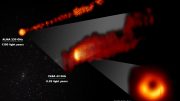


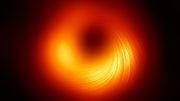
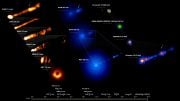
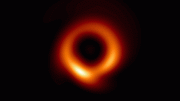
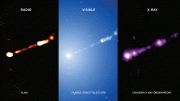
Dear Sir/Ms.
I am an Petroleum Engineer and I am not an Astrophysicist. I apologize if my comment perhaps has no basic at all.
I believed that Magnetic or Gravitational Forces consist a pair forces, such as Push and Pull Forces.
But I don’t understand why Science only saw the Pull Forces from the Black hole.
What Black hole M87 shown is the simultaneously result of Push and Pull Forces worked at this Black hole.
Thank you.
More precisely magnetic fields – which is a relativistic effects of electric fields (and their moving charges) – can naturally form dipole fields. There are no elementary magnetic charges akin to electric charges, which forms electric dipoles in say some of your petroleum molecules. But you can formally put them there in naive models of bar magnets.
Gravity is another type of force. It is easiest to see in the classic general relativistic description, since it describes a tensor and not a vector field (or a scalar field like the Higgs field).
It is natural for a vector field to have a simple field direction from charges as seen in the tool of imaginary field lines, but what about the tensor field of imaginary geodesics (“curved space”)? Here we have to look at the quantum field theory of such fields. A scalar field particle like Higgs can only have a charge and its particle must have spin 0 (looks the same from every direction). A vector field like electromagnetism can have two charges and its particles must have spin 1 (has a spin direction and takes a full turn to map the spin back to that direction). Finally a tensor field like gravity must have spin 2 (has a spin direction and takes a half turn to map the spin back to that direction ). [And matter particles has spin 1/2, which interactt with the environment such that it takes 2 full turns to map back, see gif here: https://en.wikipedia.org/wiki/Spin-%C2%BD .]
Gravity is long range, like electromagnetism, and hence its force carrier particle must, like electromagnetism, be massless. But what charge can an elementary mass less spin 2 particle have? The answer was give by Weinberg which looked at some fundamental properties of quantum particle fields caused by us living in a 3D world. (There are, perhaps surprisingly, a couple of properties that dimensions enforce on field, such as what power laws their potentials can follow and that gravity cannot be carried by a composite particle.) It is a complex analysis but it turns out that Lorentz invariance (i.e. general relativity) forces particles with spin > 1/2 such as photons (spin 1) and graviton (spin 2) to have neutral charges. Only matter particles that carry, say, electric charge can have non-neutral charges (such as positive and negative charge).
In gravity that neutral charge can be identified with mass in non-massless particles.
A simpler way to see it is to observe that the tool of geodesics can only curve space and hence act attractively if looked at through a 2D “rubber membrane” toy model.
I forgot to add that there are no immediate reason why mass is neutral, apart from that the tensor math that produces geodesics imply that gravity is always attractive (which was your original question anyway). So it is easiest to start with that and as an aside see how that gives a neutral mass “charge”.
Photons and Gravitons in Perturbation Theory: Derivation of Maxwell’s and Einstein’s Equations
Steven Weinberg
Phys. Rev. 138, B988 – Published 24 May 1965
http://pdfs.semanticscholar.org/122b/48a99a59ec04563f5198808f0d1907e4be9a.pdf
“Gravity: Space as a Rubber Sheet”
https://theory.uwinnipeg.ca/users/gabor/black_holes/slide5.html
Turbulent life of black holes, we yet to learn connection between dark matter and state of matter inside black holes, solid or not. Basically, a new state of matter anyway.
It’s not a black hole !? It’s an asteroid, rotating and with precession, explaining it’s motion. The background light is bending around the edges of it, meaning we can only see it’s dark center, that would change in diameter, shape, size, if the asteroid is irregular in shape during is rolling and rotating etc.
Good explanation, highly plausible! Another possibility is they judge things only based on knowns while there are lots of unknowns which they are unable to even consider when analyzing the data. The result is complete wrong conclusion. The size of such error is no smaller than a big galaxy, and laughable!
The so-called black hole of M87 is only an artifact due to data sampling hias. See this recent research paper (The jet and resolved features of the central supermassive black hole of M87 observed with EHT”, May 20, 2022. https://arxiv.org/pdf/2205.04623.pdf). I completely agree given the total absence of any direct proof for the physical existence of ANY black hole. Conceptually black hole is a nonsense.
Rotation of plasma matter within event horizon has a torque to produce two jets with opposite directions in gyroscopic axis at the center of galaxy,where supermassive black hole is present.Rotation is defined as the change of position of a galaxy with others in time axis.Thanks to the astrophysicsts for such fine observations in galaxy M87.